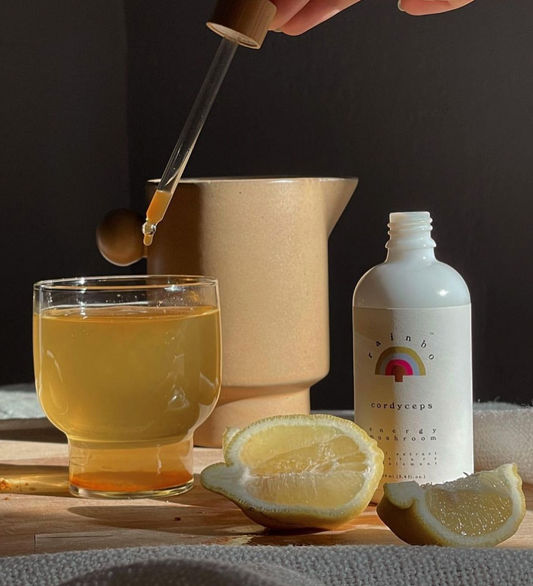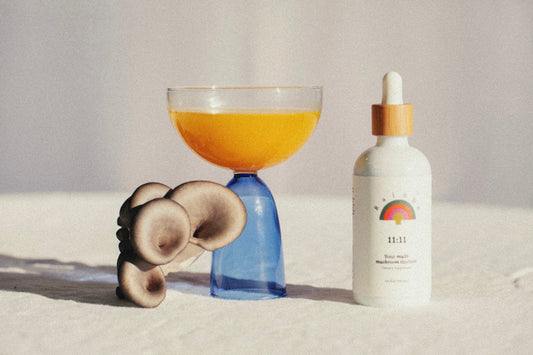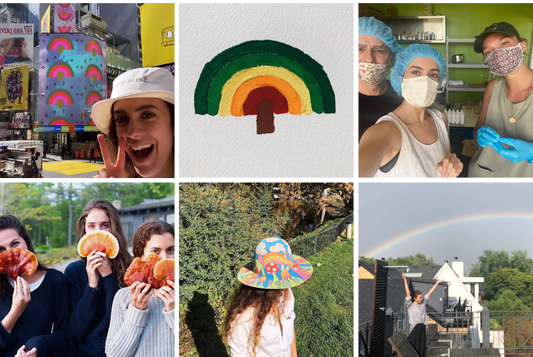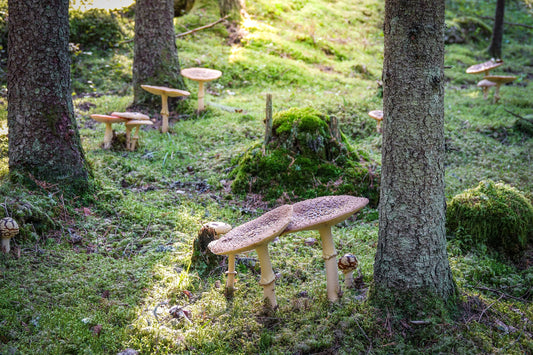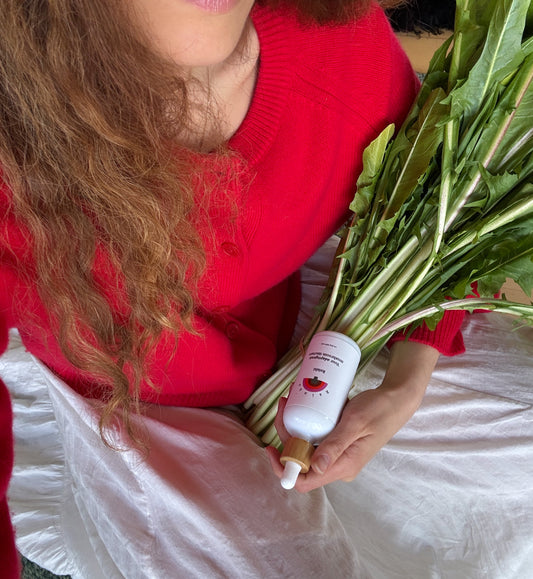The Medicinal Mushroom Lexicon
Navigating the medicinal mushroom world can come with a lot of new jargon. From fungal biology, to herbal medicine terminology to our physiological and molecular responses - the lingo can become niche and specific. Here are some of the mushroom-related words to know.
The Medicinal Mushroom Lexicon
Adaptive immune response; The second line of immune defense, this physiological response launches a highly specific attack against a particular pathogen. It does not happen immediately however it is long lasting and sustained long term due to immunological memory. Also called the acquired immune response.
Adaptogen; specific herbs and fungi that are shown to help the body adapt to stress. They do this by increasing the body's resistance to stress, supporting our defence response against stress, and helping to restore equilibrium in the body. Adaptogens are non-specific, meaning they can target multiple functions in the body. They also act independently of the individual imbalance ie. they adapt to what the body needs in a particular instance.
Antigens; a substance, typically foreign to the body, that is capable of stimulating an immune response. More specifically, this molecule or molecular structure can elicit the production of antibodies in the body.
Antibodies; proteins produced by the immune system that circulate in the blood and function to identify, bind with and neutralize pathogens in the body. Also known as immunoglobulins.
Beta-glucan; naturally occurring structural component of the cell walls of fungi, certain bacteria and cereal grains. They are composed of polysaccharide chains that differ in where the units of the chains are linked. For example, the beta-glucan links called (1>3) and (1>6) found in fungal cell walls show immunological activity when consumed while the (1>4) linked beta-glucans found in cereal grains are not immunologically active.
Learn more about how beta-glucans work in medicinal mushrooms
Bioactive compound; a substance found in food that has a biological effect on the organism consuming it. They produce "biological - activity" in the body.
Bioavailable; the property of a bioactive compound that dictates the extent and rate at which it enters into the bloodstream after being introduced to the body. If not bioavailable, it does not enter into our circulation.
BRM; a Biological Response Modifier (BRM) are substances that "modify" or influence our immune response. BRMs are also known as immunomodulators. These substances can be naturally produced in the body or come from outside of the body found in things we eat or as manufactured pharmaceuticals. These substances can either enhance or suppress the immune response.
Cap; the top part of the mushroom that is responsible for protecting the gills and spores until the mushroom reaches maturity and is ready to release spores.
Cytokine; small cell signalling molecules that aid in cell to cell communication in immune responses. There are both pro-inflammatory and anti-inflammatory cytokines.
Cytokine storm; when an overproduction of cytokines causes the body to start attacking its own cells and tissues rather than just fighting off the pathogen.
Extract/Dual-extract; an “extract” may be found in liquid or powder form and is typically made by soaking plant or fungal raw material in a liquid such as alcohol or water in order to extract and concentrate compounds from the starting material. In a "dual extract", the material is first extracted with either hot water or alcohol, and then the remaining plant material is extracted again with the other method. Next, the liquid from the first extraction is combined with the liquid from the second extraction, to form the final dual extract.
*All of our tinctures are dual extracted*
Foray; a field trip to collect wild mushrooms for the purpose of hunting for edibles, collecting for scientific study, or looking at the beauty and diversity of fungi.
Fruiting body: the reproductive structure of a fungus (produces spores). Typically seen as a mushroom. The mushroom can be shaped like a toadstool, fan, ball, coral/sponge, cup, lobe, club, phallus, star or trumpet.
Functional food; a food product that provides medicinal benefits in addition to nutritional benefits. Also sometimes referred to as a nutraceutical.
Functional mushroom; the varieties of mushrooms that have a health benefit beyond providing nutritional value.
Gills; papery thin ribs of tissue under the cap of some mushrooms that are responsible for dispersing spores (similar to the function of teeth and pores).
Hormesis: a biological characteristic that occurs when low dose exposure to stressors (such as plant and fungi phytochemicals, exercise, and intermittent fasting) activate defensive cellular responses in the body that ultimately promote cellular protection and improvement in health and longevity.
Hyphae; microscopic, branching, thread-like structure of the fungus. Hyphae represent the vegetative body of the fungus, and collectively a mass of hyphae constitutes the mycelium of the organism.
Immunomodulator; any substance that can modulate the immune system. The influence of immunomodulators can strengthen weak immune systems and control overactive immune systems.
In vitro; “within the glass” Scientific studies that take place in a test tube, petri dish or other environment abstracted from the normal biological context.
Innate immune response; the first line of defence against pathogens. It is non-specific (same response initiated to different types of pathogens) and includes physical, chemical and cellular defences.
Learn more about medicinal mushrooms and the immune response
Inoculate: introduce a new organism into a culture medium. For example, introducing spores into a substrate.
LBM: Stands for "little brown mushroom". This term can be applied to any brownish or other dull coloured mushroom that doesn't have very noteworthy features to otherwise define it.
Medicinal mushroom; specific groups of fungi containing bioactive compounds that have been shown to have health enhancing effects in the body.
What's the difference between medicinal and magic mushrooms?
Metabolite; a substance formed in metabolism or necessary for the metabolism of an organism. Primary metabolites are directly involved in the normal growth, development and reproduction of an organism's life. Secondary metabolites are not directly involved in these processes, rather they promote survival by giving the organism a competitive edge and providing resilience. Oftentimes secondary metabolites are bioactive in other organisms consuming them and have been used traditional medicine and a large range of industrial applications (eg. antibiotics).
Microbiome; the genetic material of all the microbes that live on and inside the body. It consists of bacteria, fungi and protozoa and most live symbiotically with the normal functioning of the body.
Mycelium; a mass of hyphae that constitutes the vegetative body of the fungus. Thought of as the “root” system of the mushroom.
Mycobiome; specifically, the fungal microbiome, the microscopic fungi that live on and inside the body.
Why is the mycobiome important for our health?
Mycology; the scientific study of fungi and/or the practice of cultivating them.
Learn about women in mycology and ethnomycology
Mycorrhiza; a beneficial association between fungus and a living plant root.
Nutraceutical; a product derived from natural food sources that provides both medicinal and nutritional benefits. Also sometimes referred to as functional foods.
Pin; a baby mushroom head, between the primordium and the fruiting body in the life cycle of the mushroom. Marked by the beginnings of a cap becoming visible.
Polysaccharide; The most abundant carbohydrate found in plant and fungi food sources. They normally perform one of two functions in the organism: energy storage (starch) and structural support (dietary fibre). Beta-glucans are examples of polysaccharides found in the cell walls of fungi.
Pores; tubular structures with pin-hole openings under the cap of some mushrooms that are responsible for dispersing spores (similar function to gills and teeth).
Primordium; a tiny, rounded bump formation on the surface of a fruiting substrate. Appears right before the pin in the life cycle of the mushroom.
Sclerotium; [pl. Sclerotia]; a steril hardened mass of mycelium that forms in some fungi species such as Chaga.
Spawn; any nutritious substance that has been inoculated with mycelium.
Spore; the reproductive unit of fungi that can give rise to a new organism. Spores serve a similar purpose to that of the “seeds” of most plants.
Learn more about the mushroom life cycle
Stipe: the stem or stalk-like structure that supports the cap of a mushroom.
Substrate; a material that fungal mycelium lives, grows and obtains nourishment from such as grain and wood.
Symbiotic; a partnership formed between two living organisms.
Synergy; when the interaction of biological substances produces a greater effect than the sum of the individual effects acting alone.
Teeth; or spines are spike-shaped tubular structures on the fruiting body of the mushroom that are responsible for dispersing spores. They perform the same function as gills and pores in other species. Eg. Lion’s Mane mushroom.
Tincture; A tincture is a concentrated liquid extract that is made by soaking the starting plant/fungal material in alcohol or vinegar. Tinctures use alcohol or vinegar because they are excellent solvents for extracting both acidic and basic compounds from the starting material that dissolve poorly in water alone.
Why use tinctures? and which tincture is the best for me?
A working document :)


